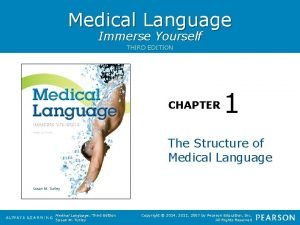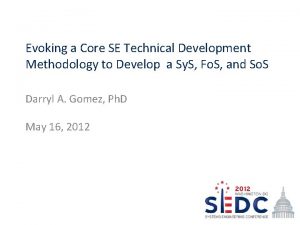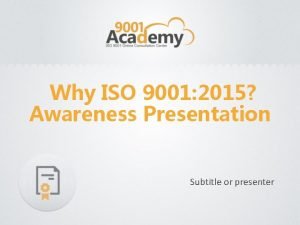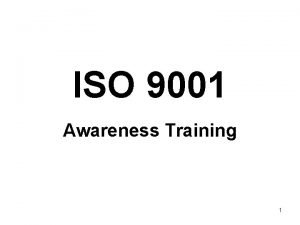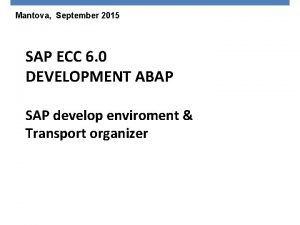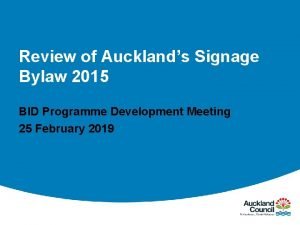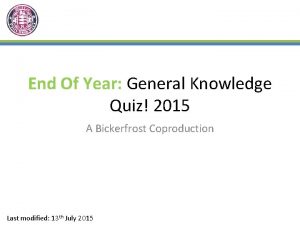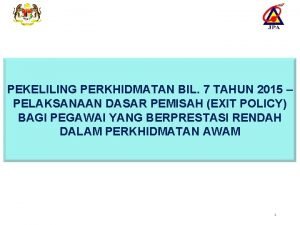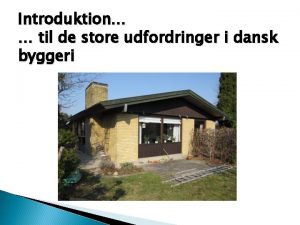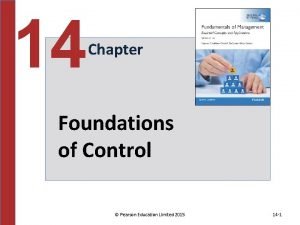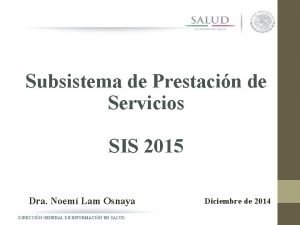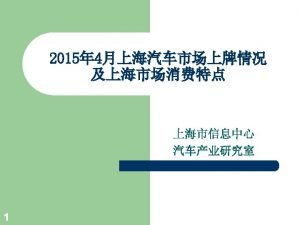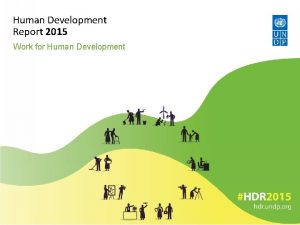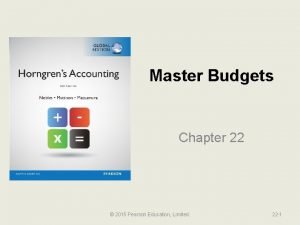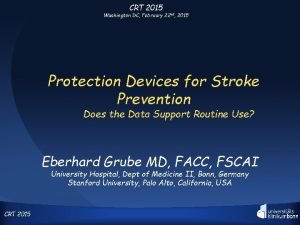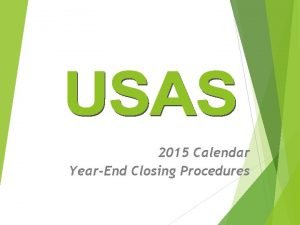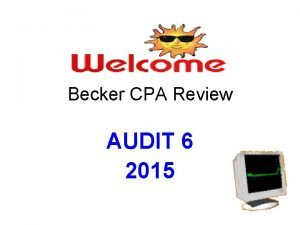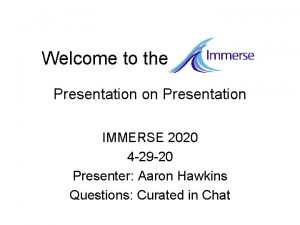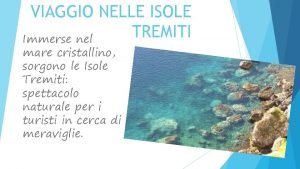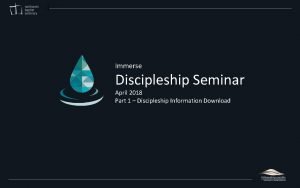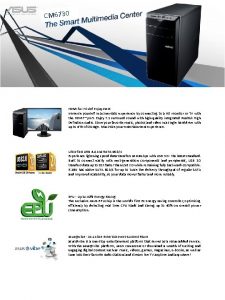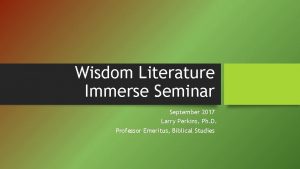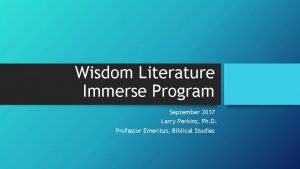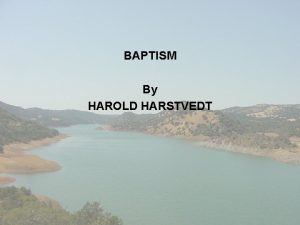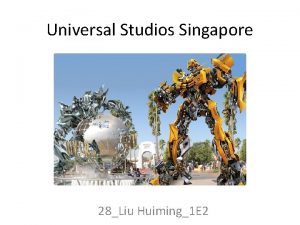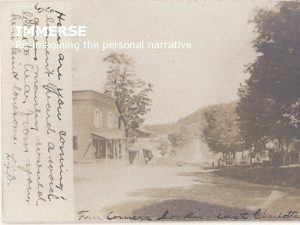Presentation on Presentation IMMERSE 2015 4 29 15























- Slides: 23

Presentation on Presentation IMMERSE 2015 4 -29 -15

Outline • Technical presentations versus other • Using Power. Point Slides • Backgrounds, colors, fonts, sizes • Organization • Too much/too little information • Content • Enough background information for your audience • Avoid equations and gory details • Emphasize big picture and conclusions • Presenting • • • Try to be natural – lots of eye contact Don’t read slides Don’t over/under prepare Don’t over/under explain Don’t go crazy with the laser pointer

Technical Presentation versus Other Presentations Technical Presentation – You do all the talking until someone asks a question – Delivering scientific results – Can have “personality” but should maintain a degree of professionalism – Power. Point Church Presentation – Usually do a fraction of talking (5% R. S. ; 10% priesthood) – Include stories, feelings, personal experiences – More personable – You ask the questions

Power. Point Presentation Guidelines Background Can’t Go Wrong Plain White Avoid Distracting backgrounds Fonts Ariel Anything distracting Text Size Bigger than 18 point Smaller than 18 point (16 point) (14 point) (12 point) Colors Lots of contrast between text and background Little contrast between text and background or distracting

Power. Point Presentation Guidelines Can’t Go Wrong Avoid Background Plain White Distracting backgrounds Fonts Ariel Anything distracting Text Size Bigger than 18 point Smaller than 18 point (14 point) (12 point) Colors Lots of contrast between text and Little contrast between text and background - background or distracting

Power. Point Organization • Title Page • Outline – can be substituted for introduction slides • Body • Summary slide outlining conclusions

What to include on a Power. Point Slide Include Graphs Diagrams/Pictures Important Equations Key measurements Conclusions Avoid Long Derivations Computer Code Lists of measurements

Two Pump Phase Matching Double Pump Configuration Single Pump Configuration Input signal fp ( f 0 ) (Pump 1) Limited tunability Converted signal Can be tuned throughout Input the whole bandwidth Limited Tunability Pump signal fin Dummy signal fc f 0 ( 0) f 1 f 2 frequency fs_d D f 1 = f 2 0: center wavelength fc = 2*fp-fin Converted signal Can be tuned throughout the whole bandwidth Dummy Pump fin fp 1 fs 1 f 0 ( 0) fp_d fc fp 2 fs 2 fp 1 = fp 2 fs 1 = fs 2 fc = fin + fp_d - fs_d • Middle of the two pumps (input signal and dummy pump) needs to be ~ 0 We tune dummy pump wavelength to get input wavelength tunability • Middle of the dummy signal and the converted signal needs to be close to 0 We tune dummy signal wavelength to get input wavelength tunability • tunability is limited by EDFA (~ 25 nm) Y. Wang, ECOC, Sep. 2005

Basic Principle: Slow Light Engineering Spectral Hole in Absorption n a Kramers-Kronig w. S a w n w. S w Sharp Gain Spectra Kramers-Kronig 0 g w. S w

Videos and Animation • Can be extremely effective • Embed and make sure it’s bulletproof • Don’t leave video looping

Technical Content Background – Adjust to your audience – What do you need to know to understand significance of what I’m talking about – Why should you care – Why what I’m doing is so great Background slides could range from 1 to most of the talk depending on your audience

Technical Content Mental state of most audience members: sleepy, lethargic, bored, distracted, defensive Things people like • Big pictures • Summary • Results • New Stuff • Simple explanations Things people don’t like • Thinking too hard • Gory details • Repetition • Endless equations • Meaningless information • Endless talking

The Act of Presenting • Try to be natural – lots of eye contact • Don’t read slides • Don’t over/under prepare • Don’t over/under explain • Don’t go crazy with the laser pointer

Acting Natural, Lots of Eye Contact Example

Integrating Microfluidics and Hollow Waveguides 4) End Coupling of Solid and Hollow Core Waveguides 5) Integration of Macroscopic Fluid Reservoirs 1) Hollow Core Waveguides 3) Intersection of Solid and Hollow Core Waveguides 2) Bends and Intersections of Fluid Channels

Don’t Read Slides Example

SIM – Key to the Operation § Electrons created during ionization are collected at N+ region. § Holes created during ionization are directed towards the P+ substrate instead of back towards the current source → avoid carrier recombination and gain suppression Fig. 4 Different carrier transportation routes within the device

Over/Under Prepare Example

Anti-Resonant Reflecting Optical Waveguides 1) Hollow Core Waveguides n 3 n 2 d 0 kx k core, n 1 kz n 2 n 3 Substrate • First proposed by Dugay et al. (1986) • High-index cladding: antiresonant Fabry. Perot cavity in transverse direction • Low-loss propagation in z-direction • Single mode • Additional layers reduce loss

Over/Under Explain Example

SU-8 sacrificial core • Rectangular core defined by photolithography • Core removal: H 2 SO 4 + H 2 O 2 Waveguide width < 10 Top layer thickness

Going Crazy with the Laser Pointer Example

Conclusions • Being well spoken in technical presentations extremely important • How strangers see you • Practice, practice. . . • Watch other people and decide what you like, what you don’t • Let’s learn from each other. . .
 Medical language immerse yourself
Medical language immerse yourself Define maturate
Define maturate Iso 9001 presentation
Iso 9001 presentation Iso awareness training for employees
Iso awareness training for employees Vertex presentation and cephalic presentation
Vertex presentation and cephalic presentation Fetal brow
Fetal brow Rd n° 160-2015/digesa/sa
Rd n° 160-2015/digesa/sa Sap 2015
Sap 2015 Signage bylaw 2015
Signage bylaw 2015 General knowledge quiz 2015
General knowledge quiz 2015 Dip 2015
Dip 2015 Pp 7 tahun 2015
Pp 7 tahun 2015 U værdikrav 2015
U værdikrav 2015 Pearson education limited 2015
Pearson education limited 2015 Sis 2015
Sis 2015 Terrorist travel prevention act
Terrorist travel prevention act 4/2015
4/2015 Human development report 2015
Human development report 2015 Pearson education limited 2015
Pearson education limited 2015 2014 geografijos egzamino atsakymai
2014 geografijos egzamino atsakymai Crt 2015
Crt 2015 2015 pearson education inc
2015 pearson education inc 2015 calendar year
2015 calendar year Becker cpa review 2015
Becker cpa review 2015
